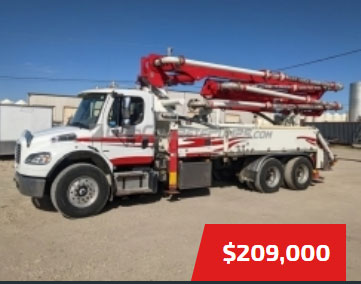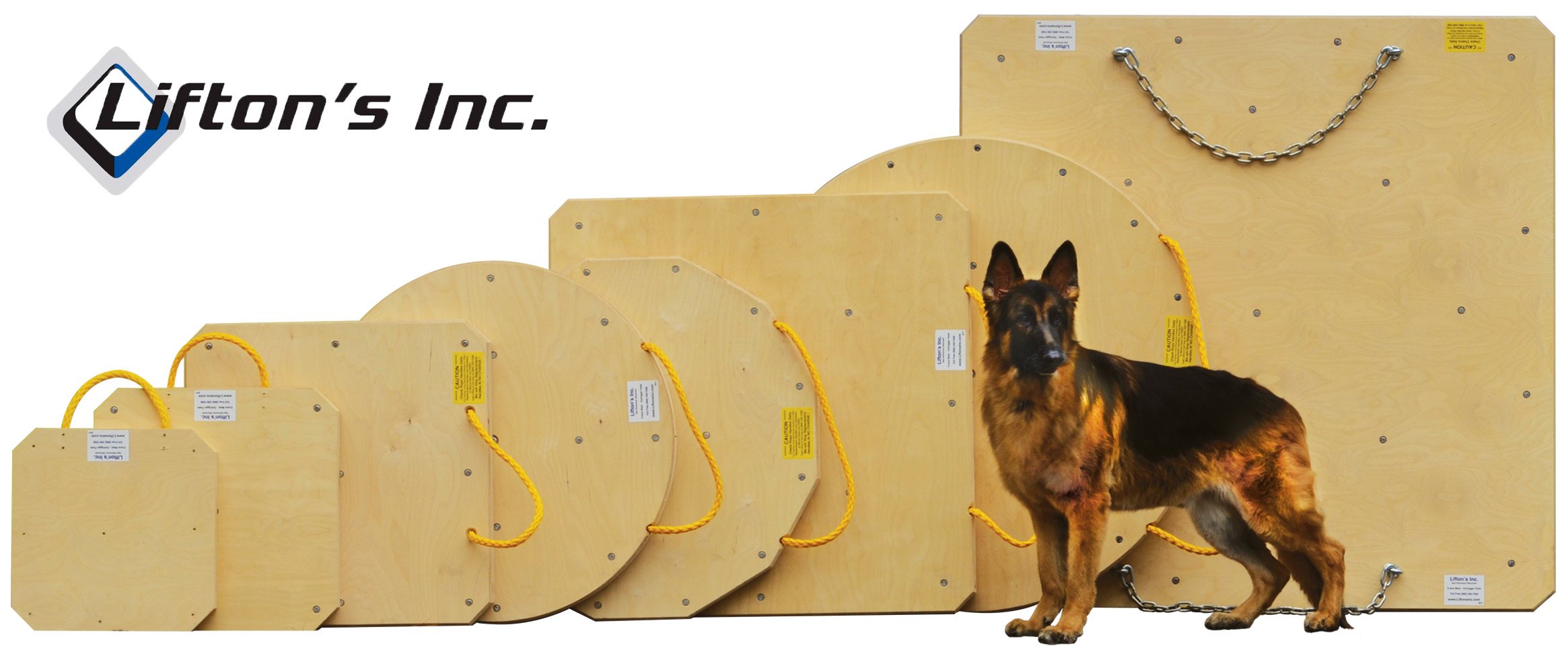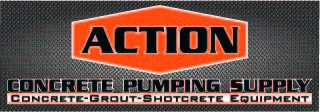Boom Parties
Boom Parties and other related Disasters
What is a boom party?
Well, it simply means that there is concrete that has set or cannot be removed by normal washout methods still in the boom. The party term comes from the fact that everyone is invited to get involved. This can be as much the trouble as it is help. What causes a boom party? The causes vary as much as the weather across the nation. Too often it is operator error. Sometimes it may be from some mechanical failure. They even happen from something being wrong with the material that no one was aware of. Operator error can be as simple as a guy sitting there not moving the mud as often as he needs to on a slow pour. It may be that he had to sit and wait on another load or that he screwed up a prime or water wash. All qualify as boom parties. The type that comes from waiting too long can be the worst because the whole boom will be full from hopper grate to tip hose. That makes the clean out extremely difficult since there are so many things that all need attention at once. We’ll use this scenario for our first example.
The Totally Full Boom/W Hopper and Pump
Lets say that we had a 36 meter full of 3000# 1” concrete. We screwed around and listened to the redi mix dispatcher tell the customer that the next load was “on the road” and we sat there knowing that it was just around the corner.... Lets also assume that there was some reason that we could not swing our boom around and re-circulate for some reason. We’re going to assume that there was a damn good reason that we did not do that, because if there was not a reason and we could have, that’s just plain stupidity or laziness and grounds for dismissal for allowing the mud to set in a boom when you had the ability to sit all day long with the tip hose hanging in the hopper moving the material and adding water as it moved. So, that was not possible and we are forced to sit there stretched out with the boom full and just sweat it out. Even then, the second most important rule in pumping comes to mind, “When in doubt, wash it out”. But, we waited 5 minutes too long so here we go....what do we do now?
First we need to evaluate the extent of the damage. How bad is it? How much of the boom is set and how’s the hopper? If anything can be washed out, do so immediately.
The pump cylinders and valve are MORE important than the boom and 10 times more difficult and costly to chip out later. If you can.....
If the hopper is still wet and we have tried to utilize the pump and it will not cycle from mud that’s too far gone, then open the rear end and first check to see if its just in the rear discharge, and second if its everything that you can see there. Lets go ahead and say the rear discharge is solid but the hopper is still somewhat wet. We need to dump the hopper and do a quick wash of the barrels and valve. this should take 5 minutes. It does NOT have to be perfect. You have other problems and time is the enemy right now.
Once the hopper, barrels and valve have been saved, its time to see what we can do with the pipeline. Get the boom down to where you can tap the pipe and see what is full and what is empty. if you have the main and second full and the 3rd and 4th almost empty, then get the blow out cap and break off an elbow at the end of the 2nd and blow the last 2 sections clear. Now if this works, you have eliminated 1/2 of the battle already, but while you were doing that, the remaining sections were setting up that much harder. Since we still have a turret, deck pipe and 2 boom sections left to clean somehow, lets say that the troops have arrived and you have some help now. You’re gonna need it too! Now, you have some choices to make. Knowing that every time that you take something apart, that it takes time to re-assemble, so if you start taking things off then you have a certain amount of time before you can do anything else. So, if you want to try something that involves the entire system, try it before you take it apart,. or your next chance to try anything else may be tomorrow when its back together. Remember that the air from the blow out is only approx 120 lbs. The water pressure from your water pump is less, if you have the system working. You have another source of high pressure right there.......the concrete pump itself.
Since we saved the pump and rear end, sometimes we get to utilize the pump to help us. When mud sets up, it looses its lubrication as well as its plasticity. Occasionally we can replace that and make the material move again. What we want to do is to fill the hopper with water if possible and button up the rear end as if we were getting ready for pumping. I like to add some celluloid primer tot he water to provide allot more lubrication that hopefully we will be able to force into the setting material. When we get the hopper full, we need to take a look at where its all going to exit, IF it does. Try to aim an elbow away from everything. If we took the elbows off at the end of the 2nd, lets aim that last pipe somewhere that the exiting mud will not damage anything.
Next, we want to make a few low power strokes forward to push the water primer up, into the pipeline and against the setting mud. When we push the thin water, we force it into the setting mud and the slick pack is also entering and lubing the mud again. We will most likely get the sudden sound of the high pressure relief valve as the pump strains to cycle against the set up mud, so we back off and go back a couple strokes and go forward again. each time we do that we force more moisture and lube back into the mud. If we’re real lucky and the mud has not set too much, and is still green, we can often get enough wet back into the pipe to make it move. What also works is to set the pump to cycle very slowly, but fast enough to maintain a constant pressure on the material. When it cycles slow, it keep water against the concrete, but it allows some to be passed back into the hopper past the cutting ring with the slow pushing. This permits it to continue to cycle on its own so you can take a break and sit down for a few minutes. This may take some time, but as long as there is constant pressure on the concrete, it will take the water and lube itself and slowly force it into the set mud. If enough gets up and in the setting mud, it will eventually move.
If it does not, then its ok to go ahead and start taking things apart since there is no hope of solving the problem any other way. What you have done at least is to wet some of the mud to aid in its removal, physically. The hard way.
First, drop the elbows and try to wash them out. This also give you some straight sections of pipe that may be able to be blown out with the air cap. But, keep in mind that if it was unable to get more moisture up into the whole section, this may not be possible with the limited air pressure.
Try to do a single section at a time. Always be careful to aim the discharge away from everything and everybody. The blow out discharge will penetrate the fender of a car, like a shot gun blast, so it should be pretty obvious that it will go right thru a human. You want to live so the manager can have a piece of you if there is anything left from your “party..”
If there is no luck in blowing the straight sections out, then its time to get physical and do it the old fashioned way. You see, half the point of this exercise is to make it very painful if it cannot be controlled early. The minute that you start beating out pipes, you’ll understand.....
What we want to do is to either hang or suspend the straight pipes and whack the hell out of the ends.. .. only the ends right on the rings. This is the ONLY place where a hammer blow will not do too much damage to the pipe so if its saved, it is usable again. This does not apply to duel wall pipe since its interior liners are as fragile as glass, and even if you do not see the damage from the hammer impacts, its there. The next time that concrete flows thru that pipe after its been hit, the liner inside will break apart and pieces will be coming apart and out with the concrete. You will not know until that pipe blows from the inner liner being gone where the soft, thin outer wrap of mild steel will wear thru quickly. This applies to hardened elbows ends, straight pipe ends that are hardened, and all hardened pipe sections of any shape. If you have these newer hardened pipe joints full of hard concrete, you simply cannot beat on them any. None at all. They will be lost if they cannot be washed out someway. And those are extremely expensive to loose to a boom party as you will learn in your lunch date with the manager....
If you are dealing with common pipe that might be just heat treated hardened but not lined, hit the ring where the clamp sits hard to make a vibration that will break up the setting concrete. Concrete does not like to be disturbed while it sets, because for a brief time it is weak. It can be broken easily when it has room to expand, but inside a pipe it is pretty well contained so the breaking must be at the surface where it will flake apart and drop from the pipe with each hammer blow. This may be in grains at a time, or chunks. That is totally up to the timing that we cannot ever be sure of. Just beat hell out of it and see what happens. Try not to ding up the pipe since a dent outside is a high spot inside that will wear right thru when mud flows thru it again. It will not last very long if it has any dents at all.
Now we still have one thing that we have to deal with if pumping water thru did not help, and blowing failed. The turret. Think a turret pipe is a hassle to change when its empty? Try it full with elbows glued to each end.
Once the rest has been dealt with in some way, now you have to do something about the turret. the vertical pipe and the elbow at each end. This is usually the piece that gets lost, that is, unable to save since its generally the last to come out being the most difficult. While we jumped all over the other easier stuff, all the sections that were easy to get to or those that had access, the mud in the turret was getting harder. If this is the only piece that we loose, then we’ve done good. The rule about the turret is that whenever it has to come apart, re-install new pieces in there since it is such a difficult piece to deal with.
Now this scenario may be typical, but its just the way that it always happens. You may have the mud set in the entire boom for any of a dozen reasons. It may be from a hot load, or mechanical failure of some sort. Whatever the reason, it can have an effect on the way that you approach the problem. You may not get help as quickly as this example suggested. If that is the case, then you have to do what you can by your self, and then make a judgment call when to call it a day and head for the shop. The more that you do on site the better the chance of getting more of it clean, but, you do not want to take too much risk while you are working alone. Its a tough call because you know that the time that it takes to drive back to the shop will allow the material to set even more.
Now, lets look at another kind of boom party.
THE SCREW UP PRIME.
This can be almost as bad except for the fact that every bit of the mud is fresh, so you have more time to deal with it. This usually happens when the prime is bad or possibly the material is too rough to pump easily. Sometimes we may even have a boom that’s too dirty inside to facilitate a good easy prime. The washout the day before was the most important thing that you did today...... First lets think about the basic bad prime.. Lets say that the prime was just gel of some sort and we got it to the 3rd section of a 4 section boom. How do we know where the plug is first of all? That’s the benefit of counting the strokes and knowing how many that it takes to reach the end of the boom. If your pump takes 9 full strokes to see mud/prime falling from the tip hose, then a plug at 7 strokes tells you that its about at the beginning of the 2nd. Why? because that 9 strokes takes it to the top of the 2nd where it is then pulled by gravity. The prime will hit the downward run of pipe and it will far out run the pump, and what you see is what the pump just got to the top of the 2nd section and maybe 1 more stroke. Now if the normal is 9 strokes and you’ve done 11 and see nothing, then that means that the prime has been lost or passed by the concrete somehow. It can be done with poor procedure. If that happens that also means that the concrete is being pushed into dry pipes and its dumb luck to get it all the way thru. If it does plug, the fix is easy as it is just about the same with all prime plugs. As soon as you realize that its plugged, stop the redi mix from discharging. If the hopper is low, that’s fine We want it to be low for this. What you have to do before getting in a panic is to suck the plug back which will pull it apart since its plugged from no lubrication and not an obstruction. You cannot pull concrete uphill, so when the boom is full from forward pumping, stop and then raise it somewhere. Look for a place that you can lift the boom to a straight up or at least 45 degrees with the tip elbow the highest. This will turn the effects of gravity around and assist you in the removal of the plug just as gravity assist you in the prime. when the boom is up, and the tip is not over anyone or anything, then cycle in reverse and count, watch the hopper and look for the level to rise. As soon as it does, go to forward as many strokes as you went in reverse. If it gets that far and does not pressure out, then go another stroke. if it keeps moving, reverse it again. What we do not want is mud being pumped out of the tip while it is 100 ft above every body’s head. When we sucked it back the first time, we would see nothing from the boom if it was plugged back in the 2nd or 3rd somewhere. But,. if it was plugged in the tip elbows, as soon as the plug broke free we would have seen a few rocks fall from the tip hose indicating that the plug had broken apart and it was now loose material again.
Now we want to lower the boom back to the A shape that we normally prime in. Since we have sucked the material back, there is little to fall out of the tip as it lowers to the ground again. Once the tip is down, we go forward again and see if it will make that 1 or 2 more strokes that it needs to go all the way. It may right away and you can go right to pumping. It may not, and it might plug again, so all that you have to do is repeat the process of sucking it back and running it forward again. It may take several attempts at this but each time that you do this, the plug is moving and when it does, it gets wet again and that means that its getting lubricated again so it will end up freefalling from the tip sooner or later. The worst of this is the hopper overflowing from running in reverse, so whenever you make forward progress, don’t let the driver fill the hopper just yet. wait to see if it will go before filling. If you must suck back again, a full hopper just ends up on the ground and that does no one any good.
That is how to deal with a prime plug. What about a separation plug from stopping half way thru the prime and allowing the primer and mud to mix and separate the rock from the water/cement? This can be handled in the same way. It may take a little more reversing in order to remix the washed out material that’s up front in the boom, so prepare to run in reverse a longer time and the hopper will likely overflow. Its still better than a boom full and no help. What you must do is to remix what has separated, and that takes a little more reversing, sometimes enough to pull it all back into the hopper. It also means that the primer will be totally mixed in with the first several strokes of concrete, so if it was a gel, you must pump more on the ground and not in the forms to be positive that you do not get the gel in a form that will hold it and ruin that section of the pour.
All prime plugs that lead to boom parties are preventable if these methods are used. Unless you have a complete power source failure, you can utilize the pump itself to correct the problem. If the pump goes down in the middle of the prime, and blow out is required, then that has to be done as safely as possible with the boom where it sits. You may have to open the rear end carefully and drain off what concrete that you can, hook up the blowout and try to blow forward if the tip is not accessible. Try to get a job compressor involved because your truck tanks will not have the pressure to blow up the boom, and especially when its got a main. deck and turret full of concrete.
It can be done though... That’s why we like to see gel or something besides water used to prime, because if the prime is interrupted when its just water, it will separate and cause real problems. If there is gel or slurry sitting there with the concrete, it will not likely separate and you will be able to resume or move the concrete as soon as either power is restored or you get the blowout gear hooked up.
All of this should be taken as a guideline for these incidents. There is no single way to approach a boom party or a plugged boom since the cause and many other things are going to vary with each incident. What I am trying to cover here, is basics. What can be done in these scenarios and we all know that it will never happen exactly as I have described here. But, this is something to work with. The best advice is to avoid the problem in the first place. Then, when it happens, do get in touch with your manager or some superior at your company that can advise and assist you in dealing with the problem. Never cowboy the problem as injury is often the result of a hero rushing in.
THE SCREWED UP WATER WASH PLUG & PARTY.
This one is one that will happen but should never make it back to the yard. Many of us water wash after our pours. Its just pumping water thru the boom to push out the concrete and clean the system. Sometimes we will have difficulties with this but they are easily remedied with a little understanding of the problem and a little patience. Panic will get you to the yard if front of everyone for no good reason.
When water washing, you are essentially causing bunches of water to interact with the concrete. We would normally never do that intentionally because we know that this will cause separation and that is a plug. What keeps that from happening every time is the fact that as long as there is positive pressure on the water and concrete, then it cannot separate and plug. Positive pressure amounts to forward motion where it has force against it that is greater than the gravity that wants to pull the rock that is no longer lubricated, back into the water. As long as the whole mess is moving forward, it won’t separate. What usually happens and this can be thought thru, is that when we fill the hopper with water, that is just about as much as 2 of 4 boom sections will hold. So we know that when we turn the pump on and pump the water down, that we are only filling to the end of the 2nd section and a little more on mid to long booms. What happens next is that gravity pulls the remaining concrete the rest of the way down and out of the last sections. We can pump water all the way under pump pressure on small booms since the pipe length is shorter, we have enough hopper volume to equal that. The problem happens when we have seen the water exit the tip, and we run out in the hopper. This is the moment of truth. At this time we now have 90% of the concrete gone, but a small amount remains in the upper area of the 2nd section where the rocks stopped going forward because we stopped pumping since we ran the hopper out of water. It’s not much, often not more than a shovel full, but that little area where the water and the concrete met and traveled together, will be a mix of rock and water. The instant that we stop, we allow the pressure to hold the mass, but the single rock can start to drift backwards from gravity. Water is thinner than concrete, so gravity can pull the few rocks back toward the turret. This is common and it is NOT a big deal. if you stop and wait for 3 minutes with the boom full of water, I can promise you that you will be semi plugged in the turret from the rock falling back from the boom. The next step in the wash process is sucking it all back into the hopper. What you will find is that nothing comes back. You hear the thumping of the pump in reverse and not a thing coming back to the hopper. We know that the boom is full of water, so what’s happening? The turret is blocked with some stone that has settled there. Is this a big deal? no, it is minor and common. Do not come unraveled yet. All that need be done is remember some simple physics and apply that knowledge to the problem. How powerful is gravity? Well, it keeps you stuck to the ground and it will keep rocks falling back toward the lowest place in the boom when they are not supported by either forward motion or thick concrete that is too dense to move thru in a confined space. Ok, that’s great, what to do? Apply this information! How do we overcome gravity in pumping? The pump does it all day long by applying more pressure to the material than the force of gravity, so the concrete is able to move upwards. We know the pump is powerful enough to do this, and we also know that reversing the pump means that the pump is not actually pumping but its really just allowing gravity to pull stuff back when the barrels are exposed. So we know the pump has the power to move what is in the turret because we also know that it is just a handful of rock, a little sand and a lot of water. The solution to the stopped up turret? add more water and go forward again. This will push the minor plug apart and break up the little rock pack and spread it around in that section of the boom pipe. As soon as we see water come from the tip again, we throw the pump in reverse wide open and suck it all back as fast as we can. This prevents the rock from having another chance to settle and block the turret elbows again and the rushing water will carry 99.9% of all the solids that are in there, the rock, sands and whatever, back to the hopper where we can simply rinse out the remains and go home knowing that our boom is as clean as the day it was assembled. No problem, no reason to panic, and certainly no need to go to the yard and freak out. Every time that someone panics and folds up thinking that he has a major problem from a water wash, he has given up before the race ever started. The ONLY thing that you assure from quitting is failure. We expect this to happen. We know it will. When we understand the dynamics of pumping and washouts, we can overcome any of these potential problems. Even the guy that gets 5 strokes of water up into his boom and has the fuse blow, should not panic. All he has to do is resume pumping and he will likely have to add more water several times because his plug is much bigger, but as long as that pump cycles, it can be worked out with water. I sometimes add slick pak to the water to add lubrication to the water so it can loosen and carry the rocks easier. if there is a real plug the slick pak will add the slippery that has been lost to dilution by the water. There is no need to get excited, and a cool head will take you further in these situations. When I train a new guy, I intentionally plug his water wash to demonstrate how easy it is to fix. It is not a big deal and you should never have to bring it to the yard to fix. Almost every time that someone has,. all we did was fill the hopper with water, pump forward, push the rocks out, and fold it up. I cannot recall the last time that we actually took something apart, because if you remember in the earlier part of this article, i made mention that each piece that you disassemble is a certain amount of time that will have to be spent to put it back together again. And if you are alone, try to get that boom pipe back on the 2nd section by yourself.... Now we have several examples of what can be done and how. We want to always keep personal safety first in any situation, so that must be the priority when removing pipes that are full, or when blowing a boom with air. It is easy to get hurt doing this when you’re pressed for time and you know that you’re running out of it. The ability to make good decisions will only come from experience and having dealt with a variety of situations, so plan on having a hard time when the first party comes your way. Always stay in communication with your office, and always remember that the absolute worst thing that will happen even if you do everything wrong, is that you loose a set of boom pipes. So, if you’re going to have to make a choice between the pump and the pipe, remember that the pipe gets tossed sooner or later anyway. Save the hopper and the pump. Hopefully with some luck and some good training, you’ll never need to know how to deal with a boom party but if you ever do, this may be of some help in knowing what to do and how to do it.
Written By Horton, Lee Published by ConcretePumping.com




















.jpg)
.gif)

.jpg)








.jpg)









